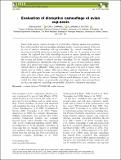Files in this item
Evaluation of disruptive camouflage of avian cup-nests
Item metadata
| dc.contributor.author | Mulder, Tom | |
| dc.contributor.author | Campbell, Cori | |
| dc.contributor.author | Ruxton, Graeme Douglas | |
| dc.date.accessioned | 2020-05-29T11:30:05Z | |
| dc.date.available | 2020-05-29T11:30:05Z | |
| dc.date.issued | 2021-01 | |
| dc.identifier | 267798308 | |
| dc.identifier | 4e483680-2f62-4016-8d7f-ce465fdd82da | |
| dc.identifier | 85085571732 | |
| dc.identifier | 000535939000001 | |
| dc.identifier.citation | Mulder , T , Campbell , C & Ruxton , G D 2021 , ' Evaluation of disruptive camouflage of avian cup-nests ' , Ibis , vol. 163 , no. 1 , pp. 150-158 . https://doi.org/10.1111/ibi.12848 | en |
| dc.identifier.issn | 0019-1019 | |
| dc.identifier.other | ORCID: /0000-0001-8943-6609/work/74873027 | |
| dc.identifier.uri | https://hdl.handle.net/10023/20011 | |
| dc.description.abstract | Parent birds employ various strategies to protect their offspring against nest predators. Two well‐researched anti‐nest‐predation strategies involve visual concealment of the nest by way of parental camouflage and egg camouflage. By contrast, camouflage of nest structures is relatively under‐researched, particularly in the case of cup‐nests in trees and bushes. We explored how birds camouflage cup‐nests in nature. Specifically, we tested Hansell’s hypothesis that birds use externally applied pale and white objects such as spider cocoons and lichens to achieve cup‐nest camouflage. To test Hansell’s hypothesis, three complementary experiments were performed: (1) an in situ nest predation experiment; (2) a photo‐based visual search experiment; and (3) contrast analyses using PAT‐GEOM software in IMAGEJ. White paper and chalk spots were used to mimic white objects used by birds in nature. Whereas predation rates in Experiment 1 were not affected by white spots, location rates in Experiment 2 were lower for natural nests with white spots than without white spots. Experiment 3 demonstrated that white spots significantly increased the contrast between different visual elements of nests. It was concluded that white objects can potentially camouflage nests against some nest predators, and that any improved camouflage was probably achieved via disruptive camouflage. | |
| dc.format.extent | 399616 | |
| dc.language.iso | eng | |
| dc.relation.ispartof | Ibis | en |
| dc.subject | Contrast | en |
| dc.subject | Lichens | en |
| dc.subject | PAT-GEOM | en |
| dc.subject | Spider cocoons | en |
| dc.subject | QH301 Biology | en |
| dc.subject | DAS | en |
| dc.subject.lcc | QH301 | en |
| dc.title | Evaluation of disruptive camouflage of avian cup-nests | en |
| dc.type | Journal article | en |
| dc.contributor.institution | University of St Andrews. School of Biology | en |
| dc.contributor.institution | University of St Andrews. Centre for Biological Diversity | en |
| dc.identifier.doi | 10.1111/ibi.12848 | |
| dc.description.status | Peer reviewed | en |
This item appears in the following Collection(s)
Items in the St Andrews Research Repository are protected by copyright, with all rights reserved, unless otherwise indicated.

